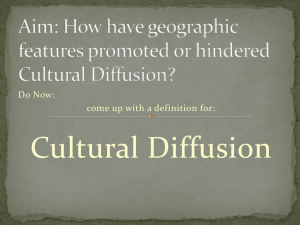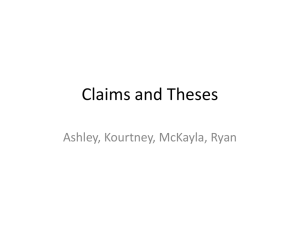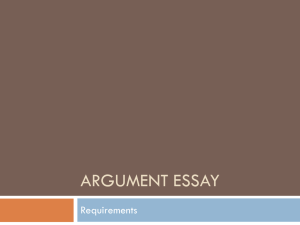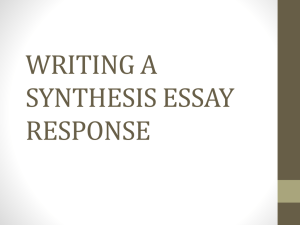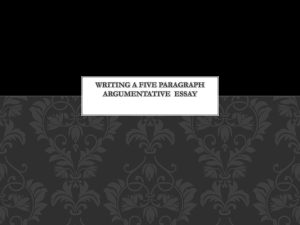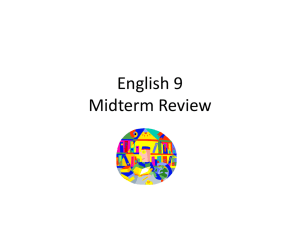Beyond the Five-Paragraph Essay
advertisement
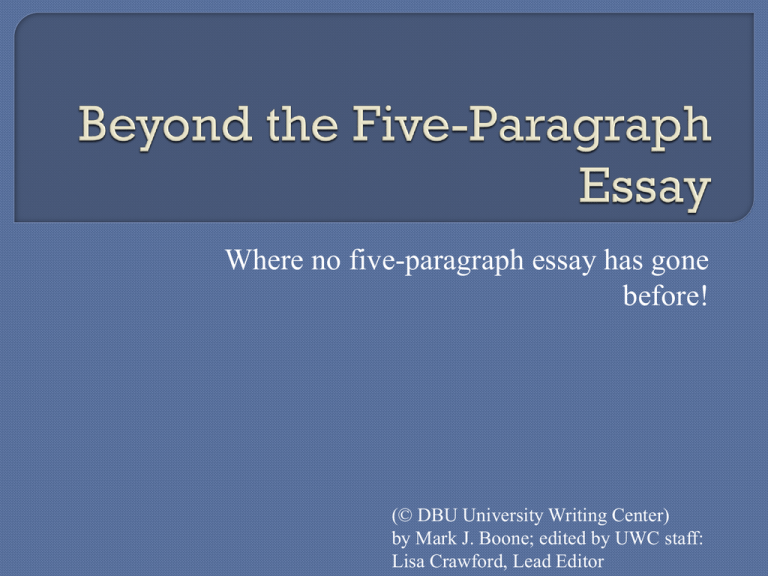
Where no five-paragraph essay has gone before! (© DBU University Writing Center) by Mark J. Boone; edited by UWC staff: Lisa Crawford, Lead Editor Review of the Five Paragraph Essay………...……………………………...slides 3-5 Go Beyond the Five-Paragraph Essay………………………………………..slides 6-7 Break the Letter of the Law; Obey the Spirit……….……………………………...slides 8-10 The five-paragraph essay has a very rigid structure. There is a thesis statement that presents a contention, or argument, with three reasons why the reader should consider agreeing with the contention. • Each body paragraph deals with one of those three reasons. The thesis statement usually appears at the end of the introductory paragraph. Each body paragraph has a topic sentence. • Topic sentences present the contention dealt with in that paragraph and sums up the coming paragraph. • The topic sentence is like a mini-thesis statement for the paragraph, but it also relates back to the thesis statement. The five-paragraph essay is usually inappropriate for some writing assignments, such as: • Composing poetry • Free writing • Composing fiction • Journaling • Writing letters The five-paragraph essay has advantages both for its writer and its readers ... • Unity. Because the thesis statement and the paper talk about the same thing, the paper is always getting its point across and never changes topics. • Clarity. Because the topic sentences summarize a section of the paper and connect that section back to the thesis, the readers are constantly being reminded how the details fit into the general idea of the paper. • Organization. Both the writer and the reader know how each part of the paper falls into the paper’s overall structure. • The five-paragraph essay is brief and concise. The five-paragraph essay basically exists so that it can be transcended. Writers are not supposed to ignore the rules of the five-paragraph essay for their entire writing career, but they should not always be governed by its elementary principles. Especially as one moves into papers that are a little bit longer than just five short paragraphs, the rules of the five-paragraph essay will have to be bent a little bit ... The first rule to stop following is the one about the number of paragraphs. • For instance, there might be a need to spend two paragraphs on one of the three points, or the introduction might consist of two short paragraphs. The next rule that does not retain its importance is the one about three main points. • Just two reasons to support the thesis are not usually enough, but four or more reasons are often useful. A guideline that does not need to be followed is that the thesis statement occurs at the end of your first paragraph. • It could occur in the middle or even at the beginning; it could even be in a different paragraph--just as long as it is still clear which is the thesis statement. But even in leaving behind the legalistic rigidity of the five-paragraph essay, one should still follow its general rules. It is recommend that several of the general rules of the five-paragraph essay be followed in extended research projects of at least 8 pages. • The thesis statement still introduces the main points of the paper. In some longer papers the “thesis statement” may take up one or two whole paragraphs and may or may not appear at the end of the introductory section of your paper. The thesis will still introduce the main points of the paper and give the reader a feel for what comes next. • Another rule writers should keep is a modified version of the rule about topic sentences. Instead of having a sentence at the beginning of each main point, simply make an effort to always explicitly connect the main point of your paper back to your thesis statement. Following these rules help to keep the paper organized and clear. • There will be fewer things that are not very important to the topic. • There will also be more things that actually support the thesis. Communication is enhanced. Readers know what is going on in the paper.
